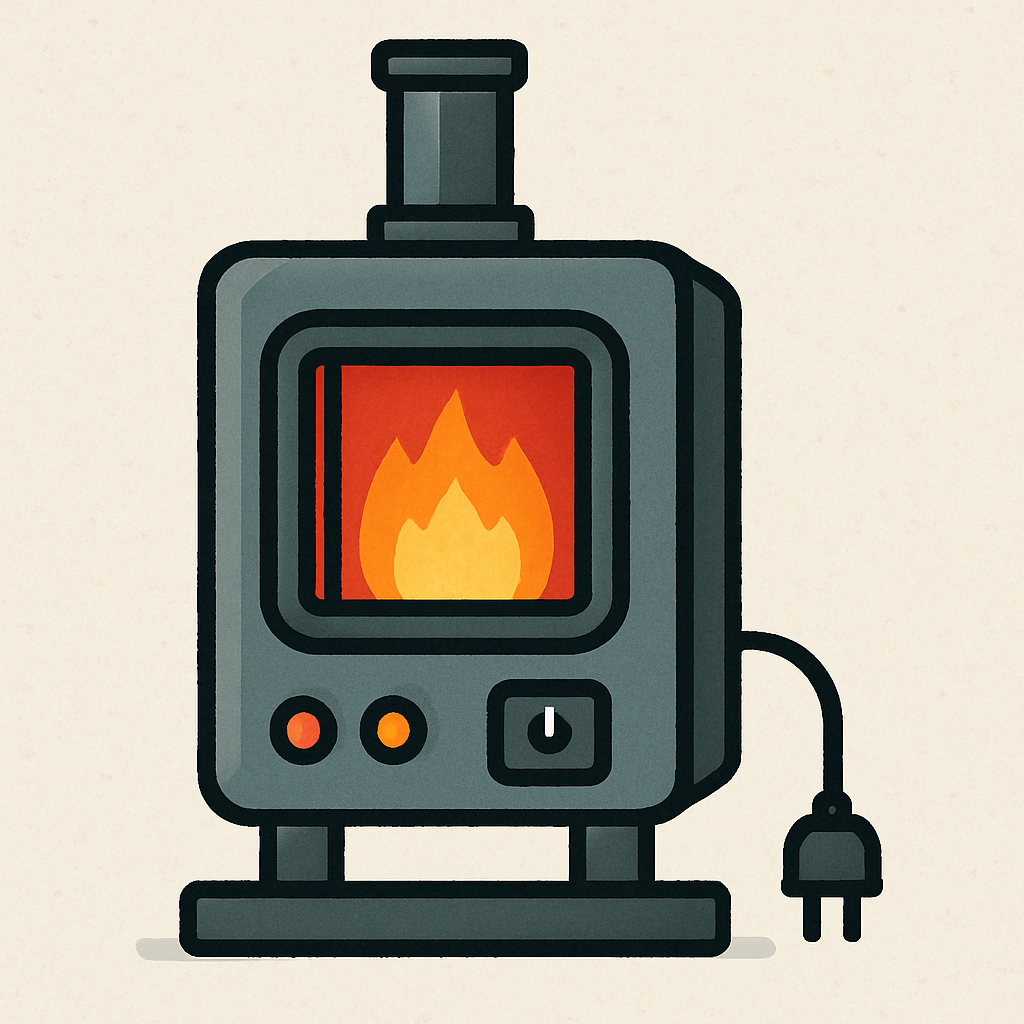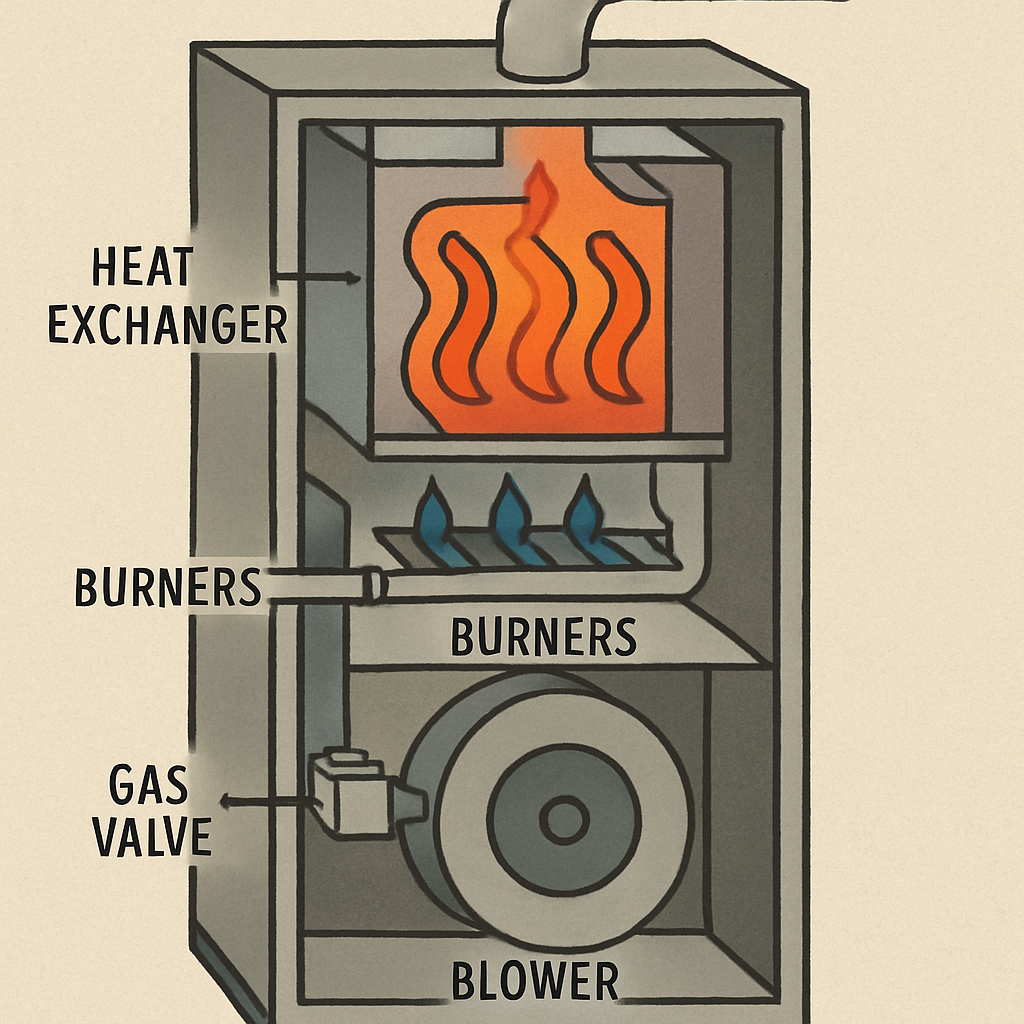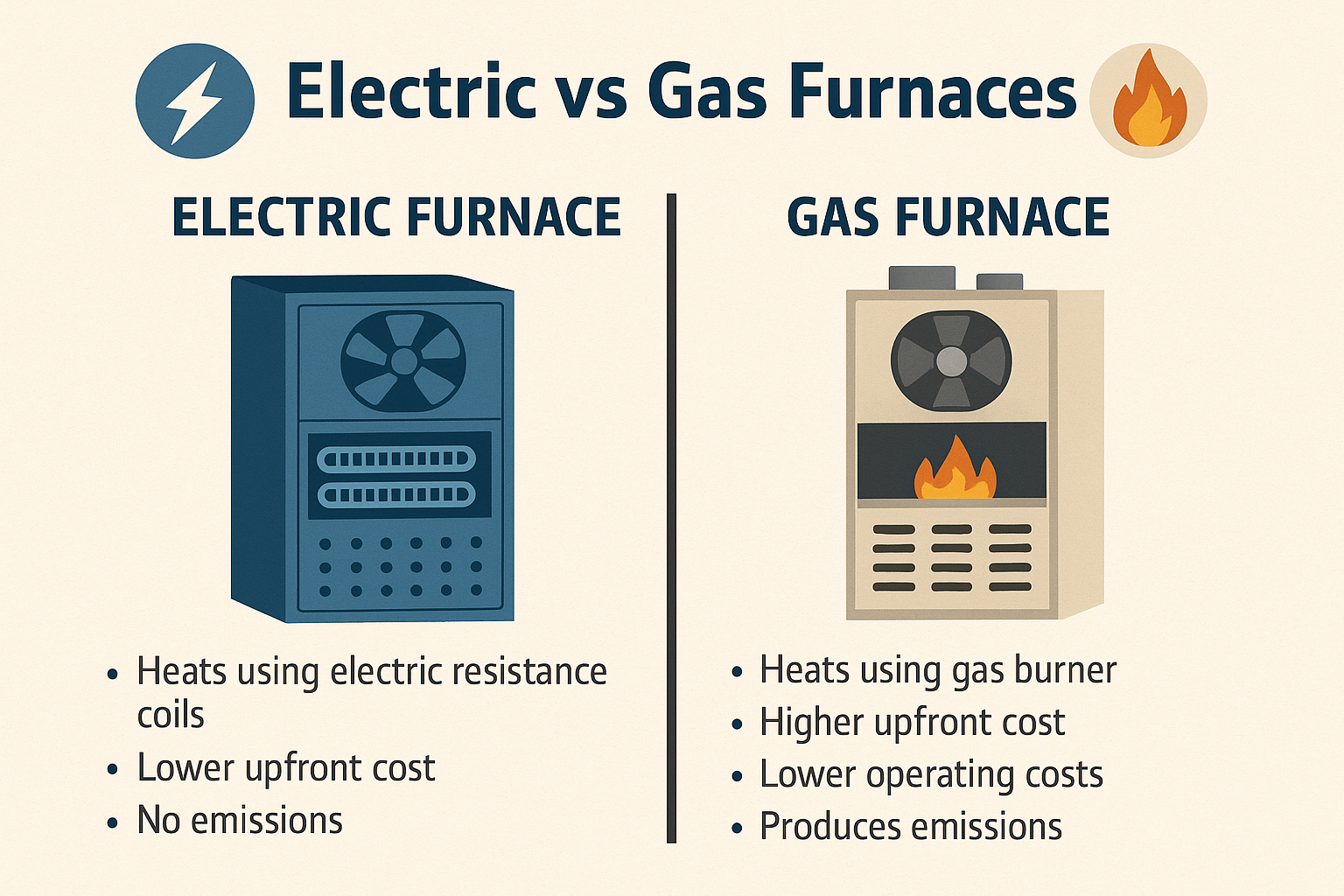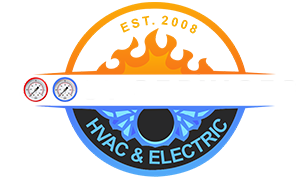As the chill of Pasadena winter sets in, homeowners face the perennial question: Should you heat your home with an electric or gas furnace? The decision can significantly impact your comfort, energy bills, and environmental footprint. In this guide, we break down the efficiency, cost, and practicality of electric vs. gas furnaces to help you make an informed choice this winter.
Before diving into the showdown, it’s essential to understand the basic types of furnaces available. Each type of furnace has its own set of advantages and disadvantages that can influence your decision based on your specific needs and preferences.

Electric furnaces are powered by electricity and use electric resistance coils to heat air. This system is often praised for its simplicity and reliability, making it an attractive option for many homeowners. The heated air is then distributed throughout the home via ductwork, ensuring even warmth in every room. Electric furnaces are known for their quiet operation, which is a significant advantage for those who appreciate a peaceful home environment. Additionally, the ease of installation and minimal maintenance requirements make them a convenient choice. However, the operating cost can be higher due to electricity prices, which can fluctuate and impact your monthly utility bills.
Another benefit of electric furnaces is their safety profile. Since they don’t use combustible materials to produce heat, there’s no risk of carbon monoxide leaks, making them a safer option for families. Furthermore, electric furnaces tend to have a longer lifespan, often lasting 20 to 30 years, which can be a crucial factor when considering the long-term investment. Despite these advantages, the higher cost of electricity, especially during peak winter months, can make them less economical compared to gas furnaces, depending on local energy rates.
Gas Furnaces

Gas furnaces, on the other hand, burn natural gas to produce heat. This method generally offers faster heating, which is particularly beneficial in colder climates where immediate warmth is necessary. Gas furnaces can be more cost-effective depending on local gas prices, offering savings on monthly utility bills. However, they require more maintenance due to the combustion process and have a more complex installation process, often necessitating professional services to ensure safety and efficiency.
The appeal of gas furnaces lies in their ability to quickly and efficiently heat large spaces, making them ideal for bigger homes or areas with colder winters. However, the complexity of their systems means they require regular maintenance to prevent issues such as carbon monoxide leaks, which can pose serious health risks. Despite these concerns, advancements in technology have improved the efficiency and safety of modern gas furnaces, making them a viable option for many homeowners. It’s important to weigh these factors carefully, considering both the short-term and long-term implications of your choice.
Efficiency: Electric vs. Gas
Efficiency is a critical factor when choosing a furnace. It’s important to consider not only the energy consumption but also how effectively that energy translates into heat. Understanding the efficiency ratings and how they apply to your specific circumstances can guide you in making a well-informed decision.

Electric Furnace Efficiency
Electric furnaces are typically 100% efficient in terms of energy conversion. This means they convert all the electricity they consume into heat, with no energy loss, making them an attractive option for those focused on energy efficiency. However, the cost of electricity can make them more expensive to operate. In Pasadena, where winters are milder, this high conversion efficiency translates well, providing consistent warmth without excessive energy use.
The straightforward design of electric furnaces also contributes to their efficiency. With fewer moving parts and no combustion process, there’s less chance for energy loss through mechanical inefficiencies or heat escaping through exhaust systems. This can lead to lower maintenance costs and a longer operational lifespan. In addition, the absence of combustion means there are no emissions directly associated with the furnace, which can be a significant advantage for environmentally conscious homeowners. However, it’s crucial to consider the source of your electricity, as this can impact the overall environmental footprint of using an electric furnace.
Gas Furnace Efficiency
Gas furnaces are rated using the Annual Fuel Utilization Efficiency (AFUE). Modern models can achieve up to 98% efficiency, meaning only 2% of the energy is lost. While the initial energy conversion is not as efficient as electric models, the lower cost of natural gas can lead to reduced operating expenses in many cases. This makes gas furnaces an attractive option for those looking to balance efficiency with cost-effectiveness.
The AFUE rating is a useful tool for comparing different models of gas furnaces, as it provides a standardized measure of their efficiency. Higher AFUE ratings indicate better performance, with more of the fuel being converted into usable heat. It’s important to consider the initial cost of a high-efficiency model against the potential savings on utility bills over the furnace’s lifespan. Additionally, advancements in technology have led to the development of condensing gas furnaces, which capture and utilize more heat from the combustion process, further enhancing efficiency. However, regular maintenance is essential to ensure these systems operate safely and effectively, as issues such as blocked flues or dirty burners can significantly reduce efficiency.
Cost Considerations
Cost is often the deciding factor for many homeowners when it comes to furnace installation. Understanding both the upfront and long-term costs associated with each type of furnace can help you make an informed decision that aligns with your budget and heating needs.
Initial Costs
- Electric Furnaces: Typically, electric furnaces have a lower upfront cost. The installation is straightforward, and there’s no need for a gas line, which can simplify the process and reduce costs. Prices for an electric furnace can vary, but you can expect to pay between $1,500 and $3,000. This lower initial investment can be appealing for those looking to minimize upfront expenses.
The simplicity of electric furnace installation also means less disruption to your home during the process. With no need for additional infrastructure, such as venting or gas lines, the installation can often be completed quickly and efficiently. However, it’s important to consider the long-term implications of this choice, as the lower initial cost may be offset by higher operating expenses due to electricity prices.
- Gas Furnaces: The initial cost of a gas furnace is usually higher, ranging from $2,500 to $5,000. This includes the cost of installation and potential gas line work, which can add complexity and expense to the process. Despite the higher upfront investment, gas furnaces can offer significant savings on monthly utility bills due to the lower cost of natural gas compared to electricity.
When considering the initial costs, it’s important to factor in any additional expenses related to installation, such as permits or modifications to existing ductwork. While the upfront cost may be higher, the potential savings on operating costs can make gas furnaces a cost-effective choice in the long run. It’s also worth exploring any available rebates or incentives for energy-efficient models, which can help offset the initial investment.
Operating Costs
- Electric Furnaces: While the initial cost is lower, the higher price of electricity can lead to increased monthly bills, especially during peak winter months. This can make electric furnaces more expensive to operate over time, particularly in regions where electricity rates are high.
The operating costs of electric furnaces are largely influenced by local electricity rates, which can vary significantly. It’s important to research and compare these rates to understand the potential impact on your monthly utility bills. Additionally, the efficiency of your home’s insulation and the thermostat settings can also affect operating costs, as they determine how much energy is required to maintain a comfortable temperature.
- Gas Furnaces: Natural gas is generally cheaper than electricity, leading to lower operating costs. However, this can vary based on local utility rates and the efficiency of the furnace. In many cases, the savings on monthly bills can offset the higher initial investment, making gas furnaces a cost-effective choice in the long term.
It’s important to consider the potential fluctuations in natural gas prices, as these can impact operating costs. Regular maintenance is also crucial to ensure the furnace operates efficiently and safely, as neglect can lead to reduced efficiency and higher utility bills. Furthermore, advancements in technology have led to the development of high-efficiency gas furnaces, which can offer even greater savings on operating costs.
Environmental Impact
Considering the environmental impact of your heating choice is crucial for many eco-conscious homeowners. Understanding how each type of furnace affects the environment can help you make a decision that aligns with your values and sustainability goals.
Electric Furnaces
Electric furnaces do not emit greenhouse gases on-site. However, the environmental impact depends on how the electricity is generated. If your electricity comes from renewable sources, such as solar or wind, electric heating can be a more sustainable option. This makes electric furnaces an attractive choice for those looking to minimize their carbon footprint.
It’s important to research the energy mix in your area to understand the overall environmental impact of using an electric furnace. Many utility companies offer green energy programs that allow you to choose renewable sources for your electricity, further reducing your environmental impact. Additionally, advancements in energy storage technology are making it easier to integrate renewable energy into the grid, which can enhance the sustainability of electric heating.
Gas Furnaces
Gas furnaces emit carbon dioxide and other pollutants during operation. While advancements in technology have reduced emissions, they still contribute to the household’s carbon footprint. This can be a concern for those looking to minimize their environmental impact, as the combustion process inherently produces greenhouse gases.
However, it’s worth noting that natural gas is often considered a cleaner-burning fossil fuel compared to coal or oil. Modern gas furnaces are designed to operate more efficiently and with lower emissions, making them a more environmentally friendly option than older models. Additionally, regular maintenance can help ensure the furnace operates efficiently and with minimal emissions, reducing its overall environmental impact.
Practical Considerations for Pasadena Homeowners
Choosing the right furnace involves more than just cost and efficiency. Practical considerations, such as climate suitability and maintenance needs, play a crucial role in determining the best option for your home.
Climate Suitability
- Electric Furnaces: Ideal for milder climates like Pasadena, where extreme cold is rare. They provide consistent warmth without the risk of freezing pipes, making them a practical choice for this region. The ability to operate efficiently in moderate temperatures can lead to energy savings and a comfortable home environment.
In areas with milder winters, the high efficiency of electric furnaces can provide adequate warmth without excessive energy consumption. The absence of combustion also means there’s no risk of carbon monoxide leaks, which can be a significant concern in homes with gas furnaces. Additionally, electric furnaces can be paired with renewable energy sources, such as solar panels, to further reduce environmental impact and operating costs.
- Gas Furnaces: Suitable for areas with colder temperatures. They heat spaces quickly and efficiently, which can be beneficial during unexpected cold snaps. This makes them a reliable choice for homeowners who need a powerful heating solution that can handle extreme weather conditions.
The rapid heating capability of gas furnaces can be a significant advantage in regions with harsh winters, where immediate warmth is necessary. However, it’s important to ensure your home is well-insulated to maximize the efficiency of the furnace and minimize energy loss. Regular maintenance is also essential to ensure safe and efficient operation, as issues such as blocked vents or malfunctioning components can impact performance.
Maintenance and Longevity
- Electric Furnaces: Require minimal maintenance and have fewer components that can fail. They typically last 20-30 years, making them a durable and reliable option for homeowners looking for a long-term investment. The simplicity of their design means there’s less risk of mechanical failure, reducing the need for frequent repairs.
Routine maintenance for electric furnaces is generally straightforward, involving tasks such as changing air filters and checking electrical connections. This can help ensure the system operates efficiently and extends its lifespan. Additionally, the absence of combustion means there’s no risk of carbon monoxide leaks, which can be a concern with gas furnaces.
- Gas Furnaces: Require regular maintenance to ensure safe operation and prevent carbon monoxide leaks. Lifespan ranges from 15-20 years, which is shorter than electric models but can still provide many years of reliable service with proper care. The complexity of their systems means they need more attention to ensure optimal performance.
Regular maintenance for gas furnaces is crucial to prevent issues such as blocked flues, dirty burners, or malfunctioning components. This can help ensure the system operates efficiently and safely, minimizing the risk of carbon monoxide leaks and other safety hazards. It’s important to schedule annual inspections and follow recommended maintenance practices to extend the lifespan of your gas furnace and maintain its efficiency.
Making the Right Choice
When deciding between an electric and gas furnace, consider the following:
- Budget: Evaluate both initial and long-term costs to determine which option aligns with your financial situation.
- Energy Rates: Check local electricity and gas rates to understand the potential impact on your utility bills.
- Environmental Concerns: Consider the source of your electricity and your carbon footprint, as this can influence the sustainability of your heating choice.
- Home Needs: Assess the size of your home and your heating requirements to ensure you choose a system that can effectively meet your needs.
By carefully considering these factors, you can make a well-informed decision that provides comfort, efficiency, and value for your home.
Why Choose BOOST SERVICES?
At BOOST SERVICES, we understand that selecting the right heating system for your home is crucial for comfort and savings. Our team of HVAC experts is dedicated to providing tailored solutions that meet your unique needs. Whether you opt for an electric or gas furnace, we ensure quality installation and maintenance services that align with our commitment to excellence and customer satisfaction.
Our experienced technicians are well-versed in the latest heating technologies and can provide expert advice on the best options for your home. We take pride in our customer-focused approach, offering personalized service and support to ensure your complete satisfaction. From initial consultation to ongoing maintenance, we’re here to help you make the most of your heating investment.
Feel the warmth of a reliable heating system this winter. Contact us today to explore your options and benefit from our expertise. Our comprehensive range of services ensures you receive the highest quality care and support, making us your trusted partner for all your heating needs.
Call us at 818-277-5056 or 747-264-6358 to schedule a consultation. Let us help you choose the perfect heating solution for your home, ensuring comfort and peace of mind throughout the winter season.
FAQ — Electric vs Gas Furnaces
What is the key difference between electric vs gas furnaces?
Gas furnaces burn natural gas or propane to create heat, while electric furnaces heat air using electric resistance elements. Both use a blower and ducts to distribute warm air through the home.
Which is more efficient for Pasadena’s 2025 winter?
At the appliance level, electric furnaces are nearly 100% efficient at converting electricity to heat, while modern gas furnaces reach 90–98% AFUE. Total operating cost depends on local electricity and gas rates, insulation, and thermostat habits.
Which has the lower operating cost: electric or gas?
In many areas, gas heat costs less per unit of heat. However, if electricity is competitively priced or you have solar, an electric furnace can be cost-competitive. Compare your local $/kWh vs $/therm to estimate bills.
How do comfort and heat delivery compare?
Gas furnaces often deliver higher supply-air temperatures, giving a “hotter” feel. Electric furnaces provide steady, even heat but may feel gentler due to lower supply temperatures and longer run times.
What about installation cost differences?
Electric furnaces are usually simpler and cheaper to install when adequate electrical service exists. Gas furnaces may need gas line work, venting, and condensate handling for high-efficiency models.
Are heat pumps a better electric alternative than electric furnaces?
Often yes. Heat pumps move heat instead of generating it, offering much lower operating costs than electric resistance heat in Pasadena’s mild winters, with the bonus of efficient cooling in summer.
Which is safer: electric vs gas furnaces?
Electric furnaces avoid combustion, so there’s no risk of flue gas leaks. Gas furnaces are safe when installed and maintained properly but require venting and carbon monoxide monitoring.
How do emissions and sustainability compare?
Gas furnaces emit CO₂ on-site. Electric furnaces have zero on-site combustion emissions; overall impact depends on the power grid mix or on-site solar. Heat pumps generally have the lowest emissions per unit of delivered heat.
What maintenance do electric and gas furnaces need?
Both require regular filter changes and annual inspections. Gas units also need burner/ignition checks and venting safety checks; electric units need element, sequencer, and wiring inspections.
What size system do I need?
Right-sizing requires a Manual J load calculation that considers your home’s insulation, windows, and air leakage. Avoid rule-of-thumb sizing to prevent short cycling and comfort issues.
Do incentives exist in 2025 for either option?
Incentives often favor high-efficiency gas furnaces, heat pumps, or electrification projects. Check local utility and state programs for current rebates and eligibility requirements.
Which system works best during power outages?
Both need electricity for controls and the blower. Gas furnaces still won’t run without power. Consider backup power (battery or generator) if outages are a concern.
How loud are electric vs gas furnaces?
Noise is similar and mostly tied to the blower and duct design. Variable-speed blowers are typically quieter and improve comfort for both types.
What are warning signs either furnace needs service?
Watch for short cycling, unusual noises, burning or chemical odors, weak airflow, rising bills, or error codes. For gas units, yellow or flickering flames warrant immediate attention.
How should I decide between electric vs gas furnaces for my home?
Compare local energy prices, available incentives, electrical panel capacity, desire for lower emissions, and comfort preferences. Request itemized quotes based on a load calculation and consider a heat pump if lowering operating costs is a priority.

